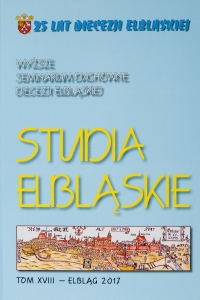Ikonografia nastawy ołtarza głównego [1693 – 1694] w poprotestanckim kościele pw. św. Piotra w Młynarach
The iconography of the Protestant main Altar in St. Peter’s Church in Młynary
Author(s): Grzegorz WąsowskiSubject(s): Christian Theology and Religion, History, Fine Arts / Performing Arts, Cultural history, Architecture, History of Church(es), Local History / Microhistory, Modern Age, Theology and Religion, History of Art
Published by: Wyższe Seminarium Duchowne Diecezji Elbląskiej w Elblągu
Keywords: Młynary; post-Protestant church; altarpiece; iconography; concetto
Summary/Abstract: The Lutheran community living at the end of the 17th century in Młynary (germ. Mühlhausen), inspired by the pillars of Protestant spirituality, ordered a new altar which was built between 1693 – 1694. The aim of this article is to describe the setting of the altar as a piece of art and its placement in the spirit of the epoch in which it was created and to present its content. „Delectare et movere” – „rejoice and move” – that is what was expected from a successful speech as well as from successful piece of art. Authors from the entire Baroque period were engaged in explaining its content and this was what provided the concetto for the most touching pieces of art. The altar in Młynary presents the place of the Lord’s supper. The motif of the road – the path from death to life also appears. Two aspects of the road are presented – the vertical one such as the vertical arm of the Cross – toward God the Father through the death of Christ to the Good Shepherd and the horizontal one such as the vertical beam of the tool of torment. The second aspect emphasizes the faith in earthly life through the word of God and baptism. The rhetoric of both ways, described in the language of art, has been clarified in the article.
Journal: Studia Elbląskie
- Issue Year: 2017
- Issue No: 18
- Page Range: 207-218
- Page Count: 12
- Language: Polish

